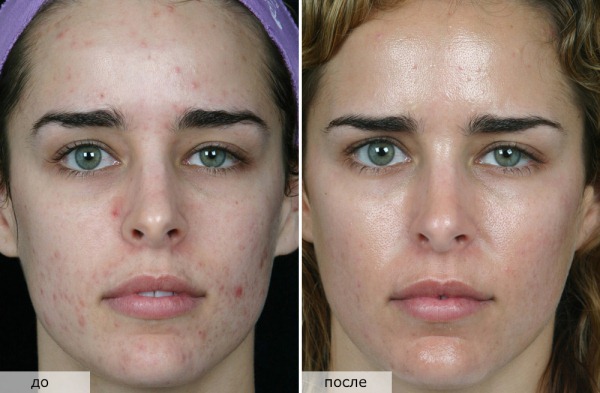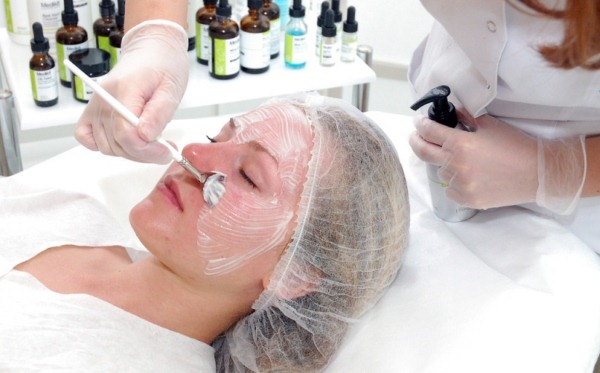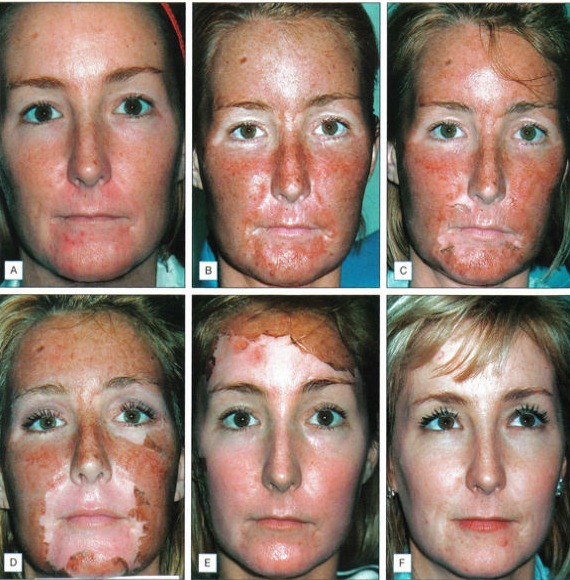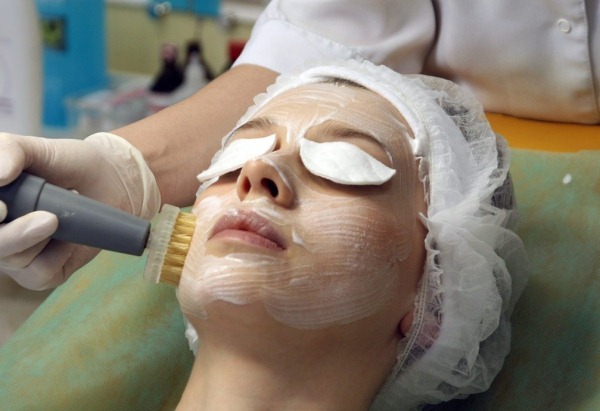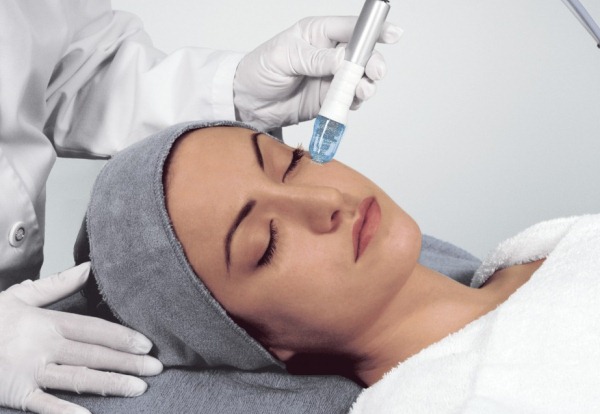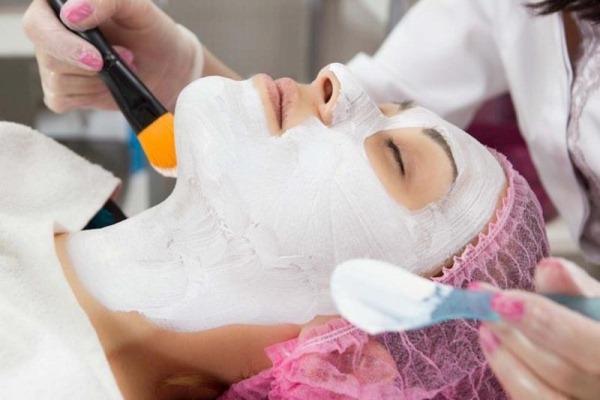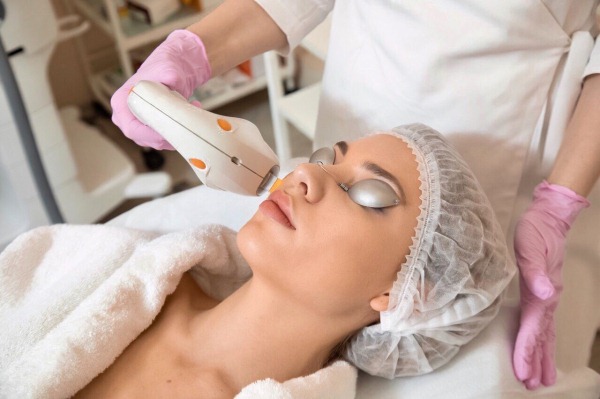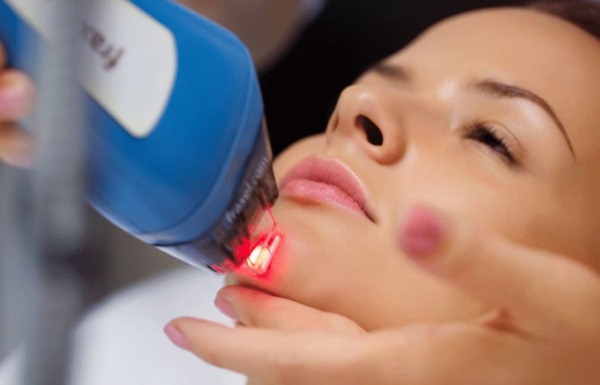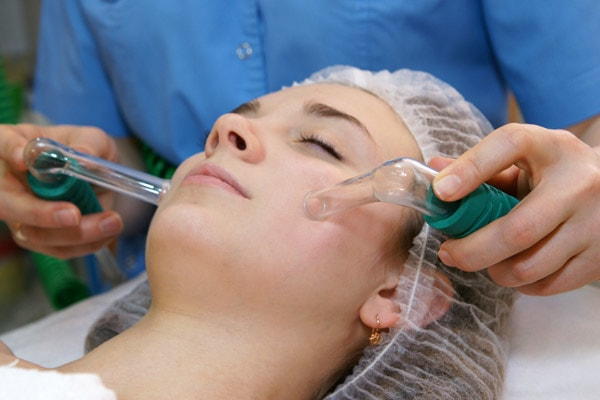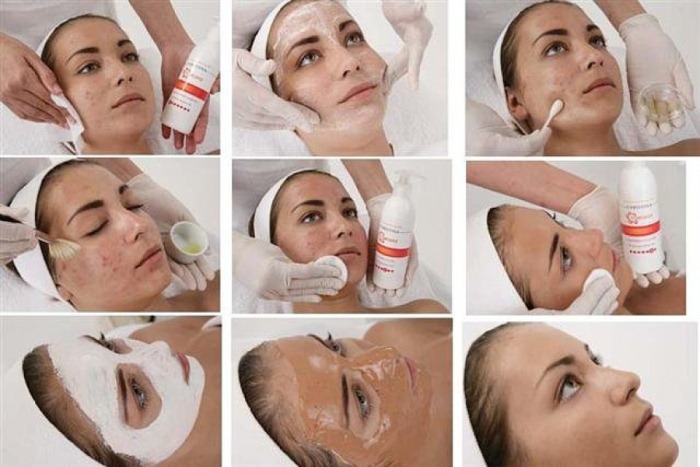In modern cosmetology, there are a variety of procedures to improve the condition of the facial skin, inhibiting age-related processes. You can achieve high results and transform your face using peeling.
All of their types for the face are aimed at restoring the epidermis by cleaning dead particles. The procedure stimulates cellular activity, improves metabolism, and accelerates regenerative processes.
What is peeling
Peeling is a complex of methods that completely or partially remove the stratum corneum in order to rejuvenate or correct external defects. Dead particles of the epidermis peel off, collagen or elastin begins to be synthesized in the cells, due to which young cells appear.
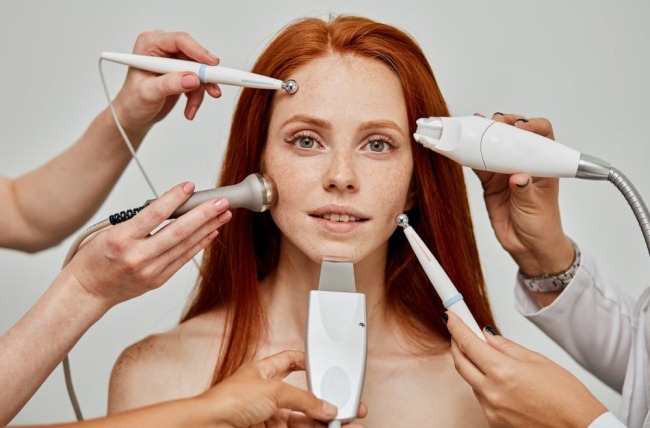
For rejuvenation and smoothing of the skin, beauticians use the technology of a cleansing mixture using trichloroacetic acid, phenol, resorcinol.
Types of facial peels in cosmetology have the following purpose:
- heal acne, pimples;
- refresh aging skin, restore its elasticity;
- eliminate external defects such as scars, scars, stretch marks;
- stop the appearance of mimic wrinkles, smooth them out;
- whiten hyperpigmentation, keratoma;
- eliminate papilloma.
The most popular areas for cleansing are the face, neck, chest, back. The effectiveness of the procedure dictates the method and depth of penetration of cleaning mixtures.
The benefits of the procedure for problematic, aged skin of the face
Complex cosmetological correction is not complete without peeling. It can be used simultaneously with injections, hardware techniques, enhancing their effect. On the adult epidermis, layers of keratinized cells are constantly forming, worsening the complexion, giving it fatigue.
Cleansing procedures have the following effect:
- contribute to the leveling of the relief of the skin;
- remove excess dirt;
- cleanse the pores;
- increase elasticity;
- allow to saturate cells with oxygen;
- prevents the early appearance of wrinkles;
- eliminates age spots.
The procedure is not complete without subsequent self-care. It consists of daily gentle cleansing of the epidermis, using a cream with UV protection.
Types of peeling in cosmetology by depth and type of action
The types of face peels in cosmetology are also divided depending on the active ingredients and the method of exposure.
Salon cleaning processes are of two types:
- penetration depth - depends on the thickness of keratinized particles;
- technique of execution - has different methods of influencing the skin, means, components, equipment used during the session.
Human skin consists of the epidermis (surface layer), dermis, subcutaneous fatty tissue (deep layer). The main cells of the main layer of the dermis are fibroblasts. They are intended for the synthesis of collagen and elastin fibers.
Surface
It is carried out using lactic and fruit acids, does not penetrate into the deep layers of the dermis, and is safe. There is no pain during the cleansing process. The procedure is carried out with a complex correction, since during cleansing, active substances from cosmetic products penetrate into the skin faster.
In the first minutes after cleaning, the skin is reddened and peeling. After several days, keratinized cells begin to cover in layers, the pores tighten, and the internal radiance of the dermis is observed.
Superficial peeling has the following effect:
- gives the face a healthy color;
- whitens pigmentation;
- eliminates yellowness;
- evens out the relief;
- reduces pronounced defects;
- prevents fine wrinkles.
The procedure is widely used to treat dry skin problems. For this, formulations with biostimulants, vitamins, bleaches, moisturizers are used. The active ingredients reduce the likelihood of inflammation, swelling, and burning.
Median
As a result of cleaning, all epidermal tissues are removed up to the papillary layer. Cleansing is carried out using trichloroacetic, salicylic, retinoic acids.
It is forbidden to use peeling with an active phase of inflammatory processes on the dermis - cleaning will increase the spread of the rash.
Median peeling has the following effects:
- improvement of complexion;
- increased turgor of the dermis;
- elimination of pigmentation;
- removal of scars, post-acne.
Cleansing sessions are categorically not recommended for women aged 35-50 years. Peeling is carried out in the autumn-spring period, during low sun activity. With strong UV rays, there is a possibility of an increase in age spots after the procedure.
Deep
It is more painful, since during the session the epidermal tissues are damaged. The procedure is carried out in stationary conditions, under anesthesia, in the presence of an intensive care team. Rehabilitation lasts 1-3 months. The main active ingredient of the product is phenol. Its use in the neck, chest, back area is fraught with the appearance of scars.
Immediately after the session, the face swells, becomes covered with bright red spots and crusts. It is strictly not recommended to tear off the keratinized particles after peeling - this leads to scarring. Within a month, the redness does not disappear, in the second month the face becomes pale pink, after which it takes on a normal appearance.
The following are distinguished from the effectiveness of deep cleaning:
- pronounced facelift;
- smoothing wrinkles;
- healthy glow of the face;
- removal of age spots.
Of the negative points, it is worth highlighting:
- hyperpigmentation;
- the likelihood of an infectious process, inflammation;
- manifestation of allergies;
- the presence of scars and scars.
Cosmetologists do not recommend deep cleansing for herpes, kidney failure, diseases of the urinary, cardiovascular system. The depth of penetration of active substances determines the duration of recovery and rehabilitation.
Mechanical peeling
Types of facial peels in cosmetology differ in the ways and use of various techniques. Mechanical cleaning occurs by spraying abrasive particles onto the skin using special equipment. It helps to remove dead cells, cleanse the dermis, restore elasticity, smooth wrinkles and scars, whiten pigmentation.
Scrubbing
Scrubs act as mechanical cleaners. Removal of dead cells occurs by means of abrasive particles that are part of cosmetic products.
For facial skin, use mild exfoliants like:
- finely dispersed vegetable powders;
- clay;
- mixtures with lumps of wax;
- algae.
The use of coffee, stone fruit, sugar, salt scrubs is suitable for cleaning hands, feet, back, chest.The wrong choice of scrub is fraught with excessive sensitivity, dehydration, rosacea. The purpose of mechanical action is to remove the upper layer of the epidermis with the help of solid microparticles.
During cleansing, the skin is smoothed, the pores are tightened, acne is removed. Cosmetologists do not recommend using scrubs for sensitive and dry dermis. A gentle scrub can be used at home. The frequency of using the scrub should be no more than 1-2 times a week. During this time, the skin is cleansed, the cells have time to renew themselves.
Products with coral chips have a surface-median mechanism of action and should be used only in the beautician's office.
Brashing
For deep cleaning use special equipment, a variety of tools and devices. With the help of special attachments, the device makes rotating movements to remove dead particles of the epithelium. Cosmetologists in their work use a variety of sponges, pumice, attachments of various degrees of hardness and sizes.
Brushing is used for:
- normalization, activation of blood circulation, improvement of metabolic processes;
- painless removal of wrinkles, scars;
- oxygenation of the skin;
- removal of blackheads, fat accumulations, dirt particles;
- whitening freckles, pigmentation.
The use of brushing is recommended for:
- age spots;
- clogged, dirty pores, blackheads, comedones;
- gray-yellow skin tone, tuberosity, uneven skin relief;
- scars, wrinkles;
- moisture deficit in epithelial cells.
With a delicate method of cleansing, the effectiveness of the procedure is manifested in a deep effect on the cover without much risk.
Microdermabrasion
Dermabrasion is based on soft, painless cleansing of the face from the stratum corneum, stimulation of regenerative processes. A special apparatus is used for cleaning. With the help of microcrystals of aluminum oxide, epithelial tissues are exfoliated, the epidermis is polished, as a result of which it is leveled and smoothed.
After 5 procedures, a rejuvenating, lifting effect is observed. After cleaning, wrinkles are smoothed, age-related hyperpigmentation decreases, the production of collagen with elastin is stimulated. The procedure is painless and safe. Immediately after the peeling, the doctor treats the skin with special serums with a regenerative effect.
Microdermabrasion is prohibited if a person has:
- increased sensitivity to the active drug;
- have rosacea or dermatosis;
- there are inflammatory, allergic diseases.
It will take 9-10 days to restore the top layer of the dermis. Subsequent procedures should be carried out no earlier than two weeks later.
Chemical peeling
The technology is based on the use of chemicals, acids. During the session, the skin gets burned, the top layer dies off, giving way to deep cell layers.
Most often, chemical peels are prescribed for:
- problem skin;
- acne, pimples;
- age spots;
- loss of elasticity, firmness;
- photoaging;
- deep, enlarged pores;
- wrinkles;
- dullness of the dermis.
Cleaning takes place using various acids such as glycolic, lactic, salicylic. When they get on the epidermis, they eat away at dead cells and accelerate their renewal. Depending on the composition, the product removes external defects. Due to the stressful environment during the session, the skin activates its own defense mechanism, thereby accelerating regeneration.
Enzyme
Of all chemical peels, it delicately and gently cleanses the epidermis. Enzymes (special enzyme substances) in the composition of the cleansing mixture improve the state of the endocrine and immune systems, improve blood circulation, and make the skin more elastic. The cleaning procedure is suitable for any type of epidermis, deeply cleanses the pores, prevents acne breakouts.
The effect is visible after the first session:
- the skin is cleansed, becomes smooth;
- relief is smoothed;
- bleached pigmentation;
- scars are removed;
- the complexion improves.
All subsequent cleanings will consolidate the success and maintain the healthy state of the epithelial tissues. When combining peeling with daily cleansing and moisturizing procedures, the result will be noticeable after a month.
Acid
Cleansing the dermis with glycolic, lactic, salicylic, fruit acids is used for:
- removing dead particles;
- elimination of external defects;
- stimulation of defense mechanisms;
- the production of collagen and elastin fibers.
Chemical acids destroy dead cells, remove fatty deposits. During the cleaning process, regenerative processes are activated, which accelerate tissue recovery and healing.
The most popular are cleansing mixtures containing glycolic, lactic, pyruvic, citric acids. They are suitable for any type of dermis. A mixture with almond, salicylic, azelaic acids is suitable for the fatty type of epidermis. Dry skin is cleansed with lactic, glycolic acid.
Combined
Combining several acids can overcome several problems. It is important to choose the right proportions of active substances, otherwise you can aggravate the problem and burn the skin. The most common peeling formulations are alpha hydroxy acids, beta hydro acids.
Alpha hydroxy acids (ANA) do not cause burns, exfoliate horny scales, interact with intercellular contacts in the dermis. A high level of ANA is dangerous for epidermolysis, but the level of trauma to epithelial tissues is much lower than with other cleaning technologies.
Standard chemical peeling protocol
The chemical cleaning protocol takes place in stages:
- first remove makeup, cleanse the epidermis;
- the active ingredient is applied to the skin with a cotton pad;
- keep the product on the skin for the time specified in the instructions;
- neutralize acid with a special alkaline composition, wash off with water;
- apply a soothing and warming mask, wash it off;
- a nourishing or moisturizing cream is applied to dry skin.
Types of facial peels in cosmetology with the use of acids are not carried out in late spring and summer - due to strong sun exposure, age spots may form.
The procedure is not performed for eczema, herpes, psoriasis, allergic reactions, trauma and damage to the dermis. Cleaning during pregnancy is strongly discouraged.
Hardware peeling
It is carried out with a special apparatus with a liquid solution, which helps to eliminate dead epithelium. Cleansing does not cause pain, discomfort, and does not provoke allergies. Hypersensitivity is possible immediately after the session.
During cleaning, elimination occurs:
- stretch marks, scars;
- acne, acne;
- wrinkles, age-related changes;
- freckles;
- bruising, swelling;
- seborrheic dermatitis.
Hardware manipulations are prohibited when:
- diseases of the ENT organs;
- viral, infectious pathologies;
- formations of unknown origin.
With the correct mechanical action on the epidermis, cells are renewed, pores are smoothed, lymph outflow improves, metabolic processes are accelerated. Hardware manipulations are performed on any type of dermis.
Ultrasonic
With superficial ultrasonic cleaning, dead epithelium is removed, and the pores are cleansed. Ultrasound is used to prepare the dermis for manual cleaning, mesotherapy, massage, and skin care programs. But it can be used as an independent procedure.
The mechanism of action is an ultrasonic wave emanating from the device. Sound waves knock out fat accumulations, dirt particles, dust. Due to the effect of cavitation, airless bubbles form in the surface of the epidermis.This softens and loosens the epidermal tissue.
The procedure is used in case of photoaging, peeling, dryness, dull, oily, combination skin. The session is not carried out with individual intolerance to the components of the product, pregnancy, high temperature, abrasions, scratches, infectious and inflammatory processes.
Laser
Occurs with laser beams. The result is determined by the type of radiation, the depth of penetration of the beam into the tissue. Laser types of facial peels differ from each other.
Laser peeling can be:
- cold - affects the upper layer of the dermis. In cosmetology it is used for layer-by-layer tissue removal without preliminary heating of the lower cells. The skin after the session becomes smooth, matte, velvety;
- hot - the stratum corneum is purified. With layer-by-layer tissue removal, the underlying structures are heated, metabolic processes are stimulated. After cleaning, the elasticity of the dermis increases, small, middle wrinkles are smoothed;
- in the form of laser resurfacing - penetrates into the deep layers of the epidermis. By destroying the old base of the dermis with a laser beam, cells are renewed, collagen and elastin fibers begin to be synthesized. As a result of cleansing, a rejuvenating, lifting effect is observed.
Laser peeling is not carried out for cancer, cardiovascular diseases, infectious processes, pregnancy, and autoimmune diseases.
Vacuum
It takes place with the use of an apparatus that creates a vacuum effect upon contact with the epidermis. As a result, pores are cleansed, tone is increased, and skin color is improved. The procedure is widely used to clean individual areas. The manipulation is painless, lasts 15-20 minutes, does not cause addiction and deterioration of the epidermis after the termination of the sessions.
Vacuum cleaning is not carried out when:
- acute dermatitis, chronic skin diseases in the acute stage;
- viral infections like herpes;
- rosacea;
- rosacea, capillary fragility and other vascular pathologies;
- increased dryness, sensitivity of the dermis.
Cosmetologists recommend vacuum peeling for adult skin. Thanks to the improved lymphatic drainage, blood circulation, metabolic processes are accelerated, toxins and free radicals are eliminated.
Which option to choose
The main task of salon cleaning is to remove dead skin along with the upper part of the epidermal tissue. Thanks to this, the skin is renewed, external imperfections are eliminated. Below are examples of popular peels.
| Procedure type | Impact type | Active components | the effect | |
| Acid | For the top layer | The active ingredients are lactic, malic, grape, citric acids. Suitable for sensitive dermis | The complexion is evened out, wrinkles are eliminated, the relief is smoothed. | |
| Glycolic | Superficial-median, depending on the concentration of the main substance | Main ingredient is glycolic acid | Suitable for narrowing pores, removing freckles, blackheads, fat deposits. | |
| For problem skin | Median | Drying of acne and blackheads occurs with the help of salicylic acid | It tightens pores, prevents the formation of blackheads, stabilizes the production of subcutaneous sebum, and has a whitening effect. | |
| Bleaching | Surface impact | Retinoic acid | Stimulation of regenerative and metabolic processes occurs, wrinkles are smoothed, the face is tightened. | |
| Laser | Deep | Laser radiation | Suitable for combating age-related changes, tattoos. It is carried out only as directed by a dermatocosmetologist in a hospital setting with the use of painkillers. | |
| Mechanical | Deep | With the help of special equipment | Eliminates scars, traces of scarring, deep wrinkles. It is carried out exclusively in a hospital under local anesthesia. | |
Where is better to do
Surface peels using light formulations can be used at home. This applies to scrubbing and vacuum manipulation. Salon face cleansing differs in the degree of skin damage, purpose, use of special devices.
You can get a full, safe cleaning only in a cosmetology clinic. The selection of the procedure is carried out by a dermatocosmetologist. When choosing a salon, you should rely on the composition of the preparations, the availability of product licenses, diplomas and experience of the master.
Peeling price in a beauty salon
The average cost of surface peels to remove impurities, open pores, and moisturize the skin is 400-500 rubles. Cleansing a medium and deep effect using quality products costs from 1,500 to 3,000 rubles.
Rejuvenating types of face peels cost from 2500 rubles. The price of complex procedures in cosmetology varies from 2700 to 5000 rubles. According to the doctor's prescription, the cosmetologist will select an individual composition for rejuvenating, moisturizing the epidermis, and eliminating skin defects.
Video about types of peels and their seasonality
What you need to know about peels:

